(July 17, 2025) Semiconductor Engineering - Is a 1024-bit DSP really the solution you want in your next chip as you fight the evolving AI battle? Or would you want a Crocodile Dundee-sized DSP solution? Quadric’s Chimera architecture is unique in crafting building blocks placing small tiles of MACs immediately adjacent to a full-fledged, programmable 32-bit ALU.

